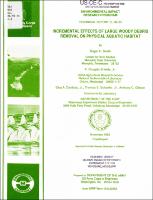Please use this identifier to cite or link to this item:
https://hdl.handle.net/11681/26032Full metadata record
| DC Field | Value | Language |
|---|---|---|
| dc.contributor.author | Smith, Roger H. | - |
| dc.contributor.author | Shields, F. Douglas | - |
| dc.contributor.author | Dardeau, Elba A. | - |
| dc.contributor.author | Schaefer, Thomas E. | - |
| dc.contributor.author | Gibson, Anthony C. | - |
| dc.date.accessioned | 2018-01-11T19:51:03Z | - |
| dc.date.available | 2018-01-11T19:51:03Z | - |
| dc.date.issued | 1992-11 | - |
| dc.identifier.uri | http://hdl.handle.net/11681/26032 | - |
| dc.description.abstract | Large woody debris (LWD) removal (also called clearing and snagging) is a widely employed practice. The LWD is removed from small channels to increase conveyance (i.e., reducing the stage and duration of high frequency flooding) and from large channels to eliminate navigation hazards. Complete removal of LWD can have detrimental effects upon stream habitats. Thus, a balance between habitat considerations and channel conveyance is necessary. Selective removal of bank and near-channel floodplain vegetation and channel obstructions is a means of accomplishing this balance. The principal objective of this study was to investigate incremental effects of selective clearing and snagging on physical conditions and aquatic habitat in a sand bed river. The study was part of a larger program to develop techniques to quantify and predict incremental physical and biological effects of LWD removal. Long-term research objectives are to relate the densities and types of LWD formations in streams to specific biotic parameters, near-bank-full friction factor, and longitudinal dispersion as an indicator of the tendency of a channel reach to trap and hold fine particulate matter. In this study, a simple method for quantifying LWD density and computing associated friction factors was developed and tested using data collected during a clearing and snagging project on the South Fork Obion River in western Tennessee. Physical conditions of both cleared and uncleared stream reaches were measured by collecting three types of data: LWD density, dye tracer tests (for computing reach mean hydraulic parameter), and physical habitat (depth, velocity, bed type, and cover) at selected transects. The LWD density was the important independent variable, while the dye tracer and physical habitat data were used to study macroscale and microscale effects of LWD, respectively. Cleared reaches had LWD densities that were 50 to 90 percent less than those for uncleared reaches. Darcy friction factors were about 30 percent less for cleared reaches than for uncleared reaches at stages greater than mid-bank. Low-flow physical habitat diversity was reduced by LWD removal. Shannon indices were reduced by 30 to 80 percent; habitat area with velocity (at 0.6 depth) less than 1 fps (<0.3 m/sec) was reduced by about 50 percent, and flow heterogeneity as measured by travel time variance was reduced by 65 percent at low flow. | en_US |
| dc.description.sponsorship | Environmental Impact Research Program (U.S.) | en_US |
| dc.language.iso | en | en_US |
| dc.publisher | Environmental Laboratory (U.S.) | en_US |
| dc.publisher | U.S. Army Engineer Waterways Experiment Station. | en_US |
| dc.relation.ispartofseries | Technical Report;EL-92-35 | - |
| dc.subject | Forest litter--Environmental aspects | en_US |
| dc.subject | Stream channelization | en_US |
| dc.subject | Rivers--Regulation | en_US |
| dc.subject | Navigation | en_US |
| dc.title | Incremental effects of large woody debris removal on physical aquatic habitat | en_US |
| dc.type | Report | en_US |
| Appears in Collections: | Technical Report | |
Files in This Item:
| File | Description | Size | Format | |
|---|---|---|---|---|
| TR EL-92-35.pdf | 26.41 MB | Adobe PDF |  View/Open |